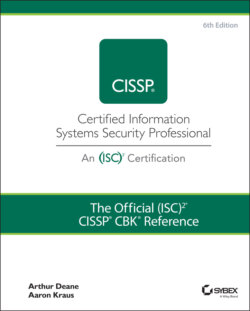Читать книгу The Official (ISC)2 CISSP CBK Reference - Leslie Fife, Aaron Kraus - Страница 30
Limitations of the CIA Triad
ОглавлениеThe CIA Triad evolved out of theoretical work done in the mid-1960s. Precisely because of its simplicity, the rise of distributed systems and a vast number of new applications for new technology has caused researchers and security practitioners to extend the triad's coverage.
Guaranteeing the identities of parties involved in communications is essential to confidentiality. The CIA Triad does not directly address the issues of authenticity and nonrepudiation, but the point of nonrepudiation is that neither party can deny that they participated in the communication. This extension of the triad uniquely addresses aspects of confidentiality and integrity that were never considered in the early theoretical work.
The National Institute of Standards and Technology (NIST) Special Publication 800-33, “Underlying Technical Models for Information Technology Security,” included the CIA Triad as three of its five security objectives, but added the concepts of accountability (that actions of an entity may be traced uniquely to that entity) and assurance (the basis for confidence that the security measures, both technical and operational, work as intended to protect the system and the information it processes). The NIST work remains influential as an effort to codify best-practice approaches to systems security.
Perhaps the most widely accepted extension to the CIA Triad was proposed by information security pioneer Donn B. Parker. In extending the triad, Parker incorporated three additional concepts into the model, arguing that these concepts were both atomic (could not be further broken down conceptually) and nonoverlapping. This framework has come to be known as the Parkerian Hexad. The Parkerian Hexad contains the following concepts:
Confidentiality: The limits on who has access to information
Integrity: Whether the information is in its intended state
Availability: Whether the information can be accessed in a timely manner
Authenticity: The proper attribution of the person who created the information
Utility: The usefulness of the information
Possession or control: The physical state where the information is maintained
Subsequent academic work produced dozens of other information security models, all aimed at the same fundamental issue — how to characterize information security risks.
In addition to security topics codified in the CIA Triad and related models, the concept of privacy has grown to be a core consideration of security professionals. Privacy, as defined in the (ISC)2 glossary, is the right of human individuals to control the distribution of information about themselves. Privacy, though often managed outside of organizations' central security team, is closely related to the principle of confidentiality and must be a priority for every organization that handles employee or customer personal information. We discuss privacy in several sections throughout the rest of this book.
For the security professional, a solid understanding of the CIA Triad is essential when communicating about information security practice, but it's important to consider related topics not covered by the triad.
